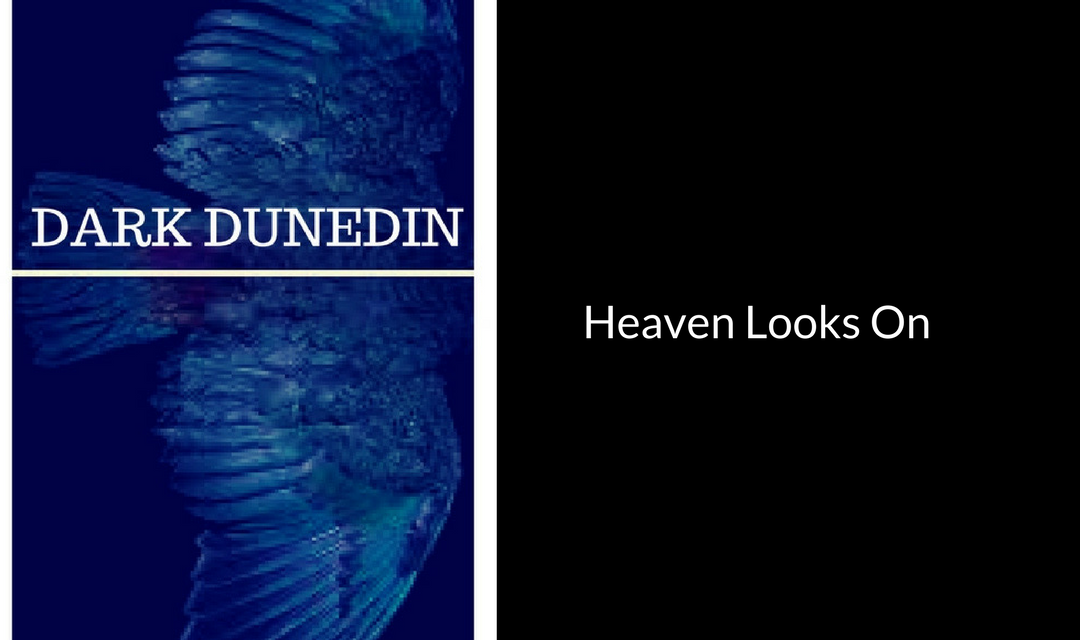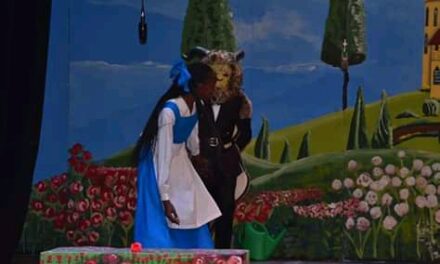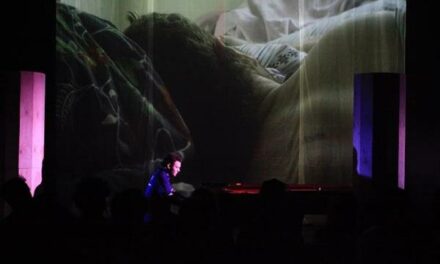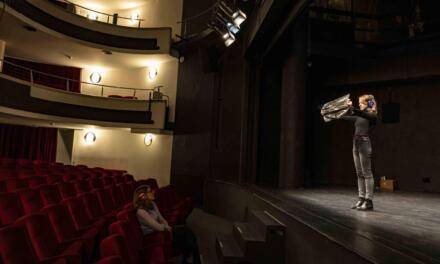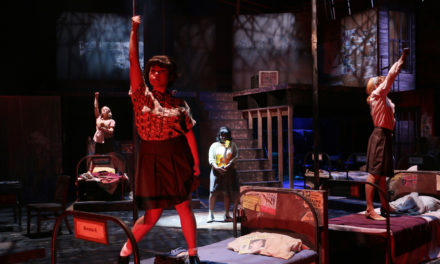An audience assembles on the grassy margins of Prospect Park in Ōtepoti/Dunedin, New Zealand, on a late summer Sunday afternoon. Numbering twenty–and a dog–we chat, admire the view, greet friends, and wait for the promenade theatre event that marks the concrete beginning of the doubly-stranded performance project entitled Dark Dunedin: Heaven Looks On. Created by Prospect Park Productions–playwright and theatre-maker Emily Duncan, and producer H-J Kilkelly–Dark Dunedin was launched at the 2018 Dunedin Fringe Festival. The project consists of this one-off promenade theatre event as well as podcasts of three episodes of an audio play, engineered by local community radio station Otago Access Radio. The first Dark Dunedin podcast entitled The City is available only to Dunedin listeners at 9 pm on the day of the promenade theatre piece that marks the event’s commencement. It is followed by two further podcasts, entitled The Victim and The Nest. The day after the promenade event, the podcasts are made available globally, but for those first hours, only Dunedin-ites can access them. The privileging of the local marks the event as unashamedly Dunedin-centric. Dunedin is a UNESCO City of World Literature, and many well-respected New Zealand writers, including Emily Duncan, are Dunedin-ites or have chosen to make this creative, artsy university city their home.
Like the promenade performance, The City begins in Prospect Park, but its cynosure is Dunedin’s green zone known as the Town Belt. The audio play opens with the discovery of a brutal assault against a young woman, Lisa Grady, and charts the ensuing events from the point-of-view of central character and narrator, Louise Hepburn. Aspects of Dunedin’s landscape, history, and fables, as well as the geographical territory traversed in the promenade, appear in Duncan’s complex and lyrically wrought audio play. From having read the company’s publicity information on the Dunedin Fringe Festival’s website, I know that several of the audio plays’ actors are amongst us during the promenade performance, as are co-creators Duncan and Kilkelly. In addition to the plays’ and promenade’s human personae, the Town Belt itself becomes almost a character in its own right. In an e-conversation I had with Duncan, she stated, “There’s something remarkable about the Town Belt in that it was planned in Scotland and now, nearly 180/200 years later it’s an important part of our ecosystem and a place of conservation” (Emily Duncan e-mail, 20th March, 2018). The promenade performance’s audience will learn more about this environment, and its real and imagined stories, as we process through the Town Belt.
At precisely 3.30pm, the Town Belt Ranger (Mark Neilson), clad in plaid bush-shirt, shorts, hiking boots, bushman’s hat, and a high-visibility vest, calls to order the group of waiting spectators. With his assistant Town Belt Ranger Cheryl (Cheryl Amos), he outlines the safety instructions for the day’s walk through the Town Belt. Through subtle “yes-saying” improvisation techniques deployed by actors Neilson and Amos, the audience learns that Ranger Mark is a kēreru [i] enthusiast and that today is Ranger Cheryl’s first day on the job. At the end of the 30-minute walk, she delightedly reports, “This is the longest I’ve ever held down a job!” In each improvised interaction during the walk, the actors provide subtle references that will be expanded in the Dark Dunedin podcasts. Ranger Mark and Ranger Cheryl don’t appear in the audio plays, which chart an altogether darker, more gothic and much more disquieting tale than rangers’ engaging and light-hearted companion piece has presaged. The Town Belt of the audio plays encloses kēhua (spirits lingering after death) and is “a place where you can believe in magic” (Dark Dunedin, The Victim). After the rangers’ safety briefing at Prospect Park, we set off, hiking along the narrow public roadway through the Town Belt. Ranger Mark calls a halt at regular intervals to point out features in the landscape or to ask general knowledge questions about Dunedin; the prize for correct answers is an Easter Egg dispensed by Ranger Cheryl. The Easter Eggs hint not only at the Town Belt’s birdlife but also at the cycle of death and rejuvenation the audio plays invoke. Sadly, too, the chocolate eggs also recall the closing of Cadbury’s Dunedin chocolate factory in 2018 with the forced redundancy of the plant’s approximately 360 workers. [ii]
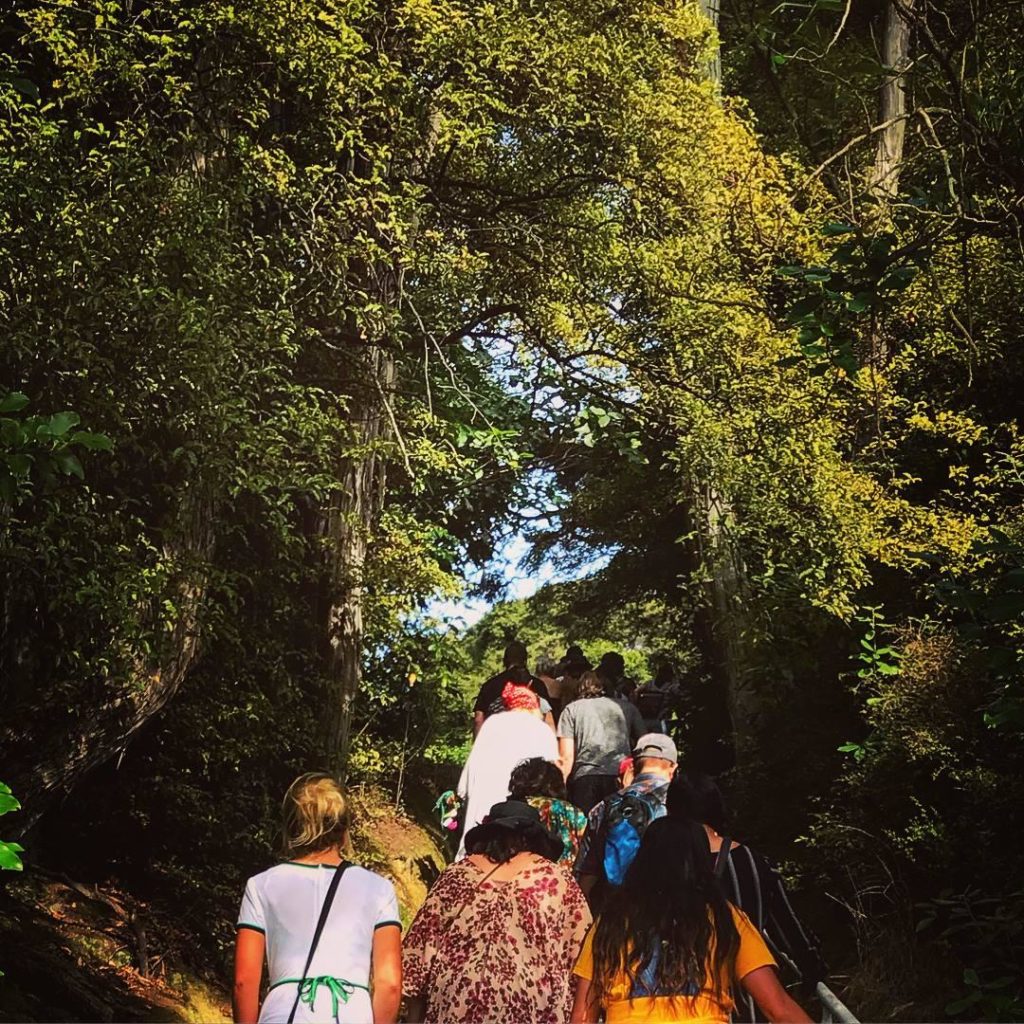
Dark Dunedin promenade performance audience members climb a path to a clearing in Dunedin’s Town Belt. Photo: Emily Duncan
At Ranger Mark’s behest, we admire colorful woodland mushrooms, shake our heads at the pile of lawn clippings dumped beside the sign requesting that no green waste be disposed of in that area, and applaud when he spots one of his beloved kēreru in a tree. Indeed, the kēreru provide an on-going motif in both the promenade and the audio plays; Duncan calls them “a barometer in the story” (Emily Duncan e-mail, March 20, 2018). As we proceed deeper into the Town Belt, Ranger Cheryl runs interference with occasional passing vehicles, and shepherds us through tracks and paths. At one interlude, in a small clearing surrounded by trees, we notice a furtive young man at the edge of the grassy area. Startled by Ranger Cheryl, he dashes away, and later, in the third audio play, The Nest, we hear about the exploits of Toby with his “nest” in the Town Belt; is this him? In the same clearing an audience member recounts an occasion when walking her dog in this area, she came across a rat nailed to a cross. Because I know that audience member is also an actor in the Dark Dunedin audio plays, I am left curious about the truth-value of this story. Real life, real history, and true stories merge with fictional theatrical representation in a way that makes it difficult to differentiate the borders of each domain. Framed by the distinctive sound of a kēreru’s wing-beats that we have heard for real during the walk, the first audio play recalls a number of elements and ideas that walkers had been exposed to during the afternoon. So subtle are the references, the possibility remains that they could simply be co-incidences; for example actor Terry MacTavish, playing Great Aunt Fenella in the audio plays, walks with us, wearing the character’s clothing colors of “peacock blues and greens” (Dark Dunedin, The Nest). When we meet at Prospect Park prior to the walk, MacTavish is enveloped by Fenella’s “cloud of Chanel Number 5” (Dark Dunedin, The City). Are these merely chance parallels, or is each nuance imbued with allusion and meaning? Indeed, Dark Dunedin suggests that co-incidences carry their own meaning and signification, which the audience accesses through a prism of echoes.
At the conclusion of the promenade, we arrive at Olveston stately home, a historic Dunedin landmark open to the public for visits and tours. It, too, receives mention in The City. Ranger Mark invites us into Olveston itself for refreshments–cheese, crackers, grapes, and coconut ice–and for the launch of the Dark Dunedin podcasts. Inside, actor Julie Edwards, who has also accompanied us on the walk, reads an excerpt from the audio play as her character Louise Hepburn. Emily Duncan points to a map, post-it notes, and slips of paper arrayed on a side table; she invites us to use these items to document our own stories of Dunedin. These stories may subsequently be enlaced into future Dark Dunedin plays. However, for Duncan,
the intention behind this aspect of the launch was to provide an opportunity for people to share/preserve their individual memories, histories or Dunedin, especially things they fear could be forgotten. (Emily Duncan e-mail, March 20, 2018)
This dramaturgical model “allows you to incorporate different histories and fill in gaps where need be to create a cogent story world with its own internal logic; you’re not confined to one official history.” (Emily Duncan e-mail, March 20, 2018). Emily Duncan’s current interests as a theatre-maker involve the imbrication to the real and the imagined in actual geographical sites. Her 2016 play Waipiata charts the layers of usage of a former sanatorium site in the Maniototo area of New Zealand’s Central Otago. Using Foucault’s concept of heterotopia, Duncan details the layers of habitation in this site of social deviations and displacement [iii] (Duncan, WaipiataPhD thesis). In Dark Dunedin, Duncan exposes archaeological layers of real, recalled, and imagined habitation and action through which we all traverse and to which we bear witness. “It’s all in the same web. Recurring patterns” says Aunt Fenella in the third audio play (Dark Dunedin, The Nest), and Louise tells this listener, “Walking is a mnemonic; you use landmarks, turns and pace to remember” (Dark Dunedin, The Victim). The project also imbricates other works including Macbeth, wherein part of the Dark Dunedin project’s title (Heaven Looks On) can be found (Emily Duncan e-mail, March 20, 2018). In one of the audio plays, Louise attends a performance of Macbeth at Dunedin’s iconic Globe Theatre with her sister-in-law Sarah (Dark Dunedin, The City). In addition to referencing Dunedin’s heritage as so-called “Scottish” city, Macbeth’s living wood chimes with Dark Dunedin’s characterization of the Town Belt (Emily Duncan e-mail, March 20, 2018).
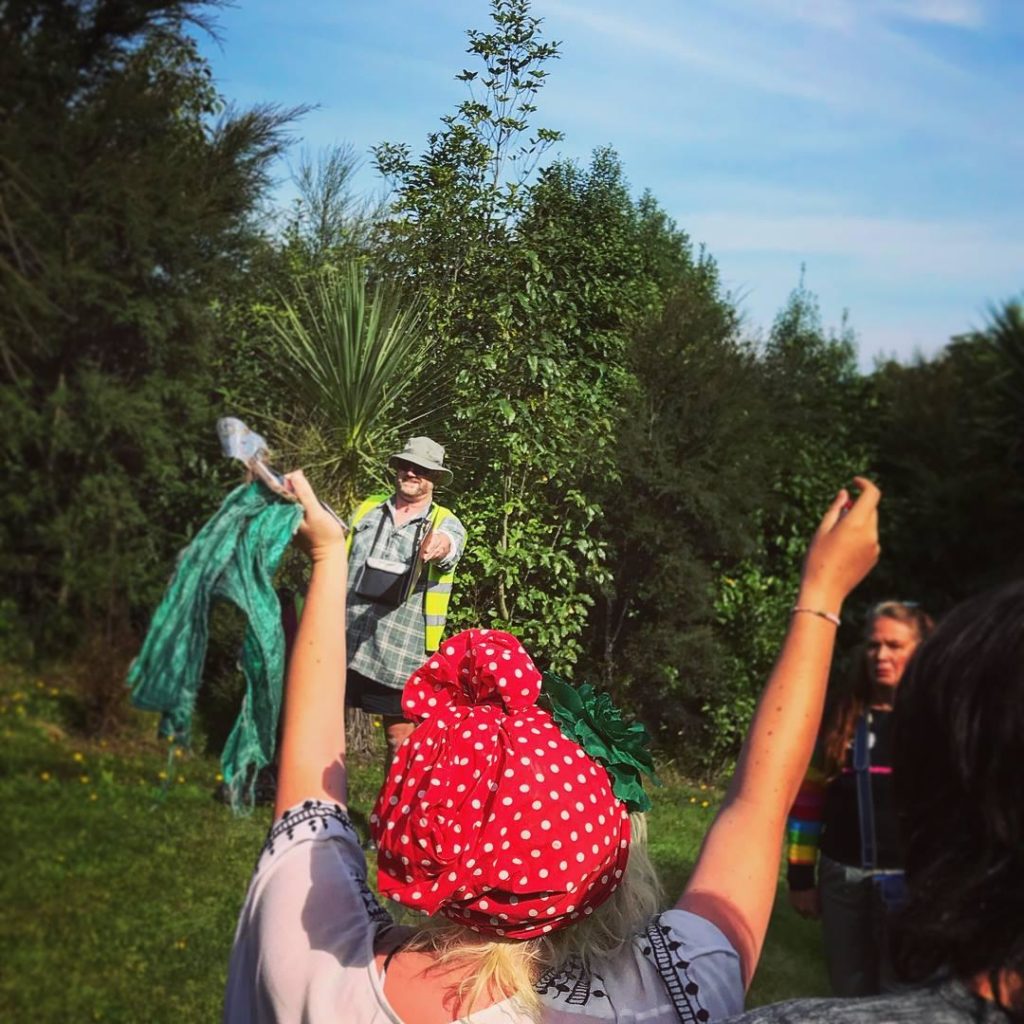
Town Belt Ranger Mark (Mark Neilson) interacts with an audience member on the Dark Dunedin promenade performance. Photo: Emily Duncan
Despite the benevolent stewardship of Ranger Mark and Ranger Cheryl, the promenade through the Town Belt places the audience in a position of some agency, and blurs the borders between performer and spectator. We become active spectators; I propose to Ranger Mark an alternative explanation for the lawn clippings dumped beside the sign (maybe the sign was erected after the clipping were dumped), and one audience member cheekily barks when Ranger Mark asks us to make the sound of the kēreru’s wings. The audio plays, too, require listeners to work actively, to solve a puzzle, and to consider alternative explanations; the story Louise tells in the audio play of a “boiling cauldron of secrets” (Dark Dunedin, The Nest) comes into being through its revelation of asynchronous layers of excavation and memory. A further layer of signification becomes apparent through my e-mail conversations with Emily Duncan. She lives with a chronic health condition and is an “avid listener to podcasts” because “they allow her to continue to engage in the world of theatre, literature, and arts in general when she is prevented from doing so outside the house” (Emily Duncan e-mail, March 20, 2018). Indeed, the rhythm of writing, editing, directing, and recording the radio plays meant that Duncan could manage these artistic tasks with a degree of agency alongside her health condition (Emily Duncan e-mail, March 20, 2018).
Dark Dunedin: Heaven Looks On interlaces geography, history, stories, hearsay, and fiction through multiple narratives in Duncan’s poetic, perceptive writing, and has at its physical and emotional epicenter Dunedin’s Town Belt. The project features professional actors alongside more novice performers, and the promenade performance includes spectators in both the making of its meaning and in its execution. Thus, the venture is a true community event, mobilizing audiences and theatre-makers through a fusion of the numinous with every day in Duncan’s sometimes elegiac, sometimes funny and earthy writing, and in her creation of a Dunedin mythos. Dark Dunedin: Heaven Looks On won the “City of Literature Beyond Words Award in association with Dunedin UNESCO City of Literature” in the 2018 Dunedin Fringe Awards.
Readers can access the audio play Dark Dunedin: Heaven Looks On at https://oar.org.nz/event/dark-dunedin-heaven-looks-on or on iTunes.
Notes
1. New Zealand native Wood Pigeon.
2. “Mondelez International – an offshoot of the giant American company Kraft – took control of Cadbury after a hostile takeover launched in 2009” and although the factory was profitable, “[i]t was earmarked as just one of several Mondelez factories to close.” (McNeilly. “Death of a Chocolate Factory”.)
3. Waipiata also functioned as custodial residence for young offenders and later as the location for a religious community.
Works Cited
Duncan, E. T. (2016). Waipiata: A Practice-Led Exploration Of Heterotopic Playwriting (Thesis, Doctor of Philosophy). The University of Otago. Retrieved from http://hdl.handle.net/10523/7012
Duncan, Emily. E-mail conversation with the author, March 20, 2018
McNeilly, Hamish. “Death of a Chocolate Factory: No Fairytale Ending of Cadbury Workers”, Otago Daily Times, March 23, 2018.
This post was written by the author in their personal capacity.The opinions expressed in this article are the author’s own and do not reflect the view of The Theatre Times, their staff or collaborators.
This post was written by Hilary Halba.
The views expressed here belong to the author and do not necessarily reflect our views and opinions.

